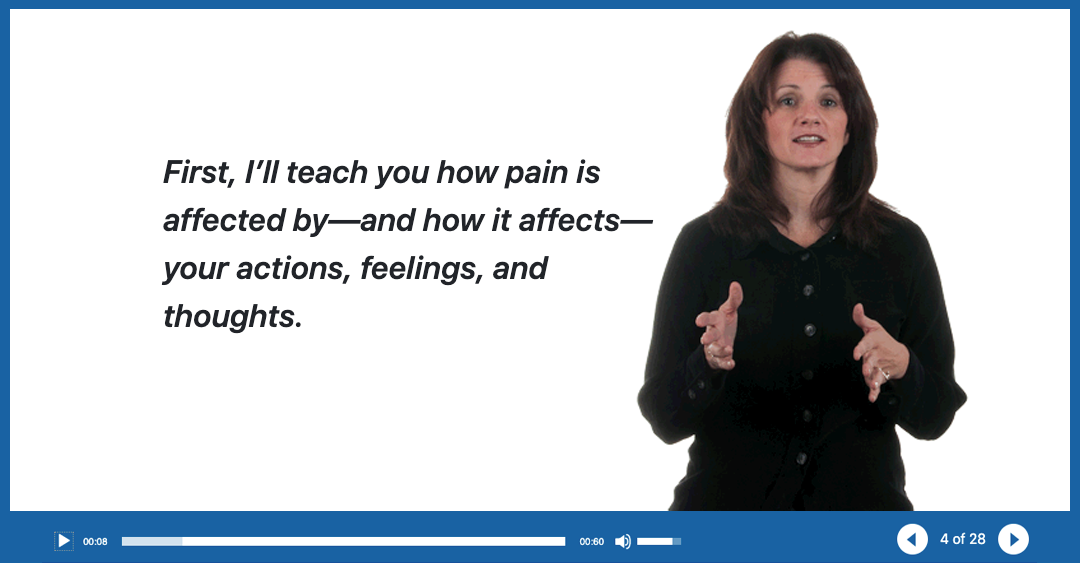
A screenshot shows the online pain coping skills training program, which teaches people how to manage their pain. Image courtesy of the Feinberg School of Medicine at Northwestern University.
“Hi, and welcome to your first session.” Kelly appears on a computer screen.
“First, I’ll teach you how pain is affected by — and how it affects — your actions, feelings, and thoughts,” she says. “Then I’ll teach you the first pain coping skill.”
Kelly is a virtual guide on a free interactive, online program that teaches people scientifically proven coping strategies they can use to improve their daily lives by managing their own pain.
Lynn DeBar, Ph.D., a psychologist and behavioral researcher at Kaiser Permanente Washington Health Research Institute in Seattle, and her colleagues are evaluating this interactive, online tool that teaches cognitive behavioral therapy (CBT)-based pain coping skills. Her team is comparing the online pain coping skills training program to a similar treatment delivered by telephone as ways to help people manage their own pain. Her research is part of the Pain Management Effectiveness Research Network, which seeks to evaluate the effectiveness of a broad range of therapies for a variety of pain conditions, within the Helping to End Addiction Long-term® Initiative, or NIH HEAL Initiative®. The initiative is fighting the opioid crisis from many angles, including by finding new ways to enhance pain management through clinical research.
Retraining thoughts about pain
In 2016, an estimated 1 in 5 U.S. adults — tens of millions of people — experienced chronic pain, which is defined as pain lasting at least three months. When pain is caused by a recent event, such as an injury or surgery, treatment often involves pain relievers and rest. But when pain turns into a long-term problem, treatment gets complicated and often does not work.
“Things really shift when people have more persistent pain,” DeBar said.
Opioids may be helpful to relieve acute pain but are often less effective when used to treat long-term chronic pain. People may need increasing doses over time to get the same relief, raising their risk for dependence and overdose. For some people, using opioids can make them even more sensitive to pain.
The online pain coping skills training program is based on the principles of CBT, a kind of psychological therapy shown to be effective in treating mental health and other conditions. CBT has long been used to treat chronic pain, with good results. Although negative thoughts do not cause pain, DeBar said, they can make pain worse. CBT can teach people new ways to think about their pain, to better cope with it and get back to their lives even if they are hurting.
“It’s skills training,” DeBar said. “It’s giving people the confidence that they can do things in real time in their lives to manage their condition.”
Advances in understanding of the brain have shown that regions involved in pain are closely linked to thinking and emotion. With CBT, many people can retrain their thoughts and emotions.
“The ability to manage thoughts and behavior and really look at making modest behavioral changes in your day-to-day life might make you less disabled and may even decrease the pain over time,” DeBar said. “As you’re able to get more active and you’re not as fearful, you aren’t as reactive to the pain.”
Scaling up and reaching out
In an earlier study, DeBar and her colleagues found that CBT could be integrated into the usual medical care of people with chronic pain. However, the researchers also noticed that patients, especially those with severe pain, often had challenges in getting to their appointments. So, for the NIH HEAL Initiative study, DeBar’s team is exploring ways for patients to access CBT remotely.
One of those ways is using an interactive, online tool for teaching people coping skills to manage and reduce pain. Just as a live therapist would, Kelly, the program’s virtual coach, walks people through learning about chronic pain and practicing skills that can make living with pain easier. For example, Kelly leads participants through a technique called progressive muscle relaxation, which helps people recognize tension in their bodies and consciously relax their muscles.
The program is divided into 8 sessions, meant to be completed over about 8 weeks. The first session includes education on pain and relaxation. Later, Kelly talks about topics such as how to ease into physical activity and return to activities the person used to enjoy.
DeBar expects the study to recruit about 2,300 people with all kinds of chronic pain conditions and from across the country, including rural areas where treatment options can be scarce. A third of participants will use the online CBT-based pain coping skills training program; another third will be given similar sessions by phone with a coach in Seattle who has been trained in using CBT for chronic pain; and, as a control group, the final third will be given written information on how to live well with chronic pain.
Other HEAL-supported projects are testing online tools to manage specific pain conditions. One research group is testing online pain coping skills training along with medication treatment for people who have knee pain from arthritis; the idea is that people may be able to avoid surgery if they can cope with the pain better. Another group is planning to test the training program’s use in managing chronic pain in cancer patients who have pain that is caused or exacerbated by their cancer diagnosis or treatment. These groups are all part of the Pain Management Effectiveness Research Network, an NIH HEAL Initiative program to evaluate how different pain therapies work for a variety of pain conditions.
Looking forward
DeBar and her colleagues will check whether participants’ pain improves and how much the pain continues to interfere with daily life. The team also plans to ask about each person’s quality of life, such as how well they are sleeping (pain often prevents a good night’s rest) and will compare the costs of the online approach compared to therapy by phone.
The researchers hope that by learning to deal with pain, people will need fewer visits to the doctor or emergency room and other expensive interventions; patients may even be able to reduce the amount of pain medicine they take. DeBar’s team will follow up with study participants after a year to see whether the effects of the therapy have lasted.
“We’re saying, if this doesn’t last up to a year out, that’s not a potent intervention,” DeBar said. “The idea is, you learn these things and then you use them in your day-to-day life, and you should get enduring benefits.”
References
1. Dahlhamer J, Lucas J, Zelaya, C, Nahin R, Mackey S, DeBar L, Kerns R, Von Korff M, Porter L, Helmick C. Prevalence of chronic pain and high-impact chronic pain among adults — United States, 2016. MMWR Morb Mortal Wkly Rep. 2018;67:1001–6.

Read About This Project on NIH RePORT
Learn more about DeBar’s project, “Tailored Non-pharmacotherapy services for chronic pain: Testing scalable and pragmatic approaches."

Find More Projects in This Research Focus Area
Explore research programs and funded projects within the Clinical Research in Pain Management focus area.

National Institute of Neurological Disorders and Stroke (NINDS)
Learn more about NINDS’ role in the NIH HEAL Initiative.
 U.S. Department of Health & Human Services
U.S. Department of Health & Human Services
